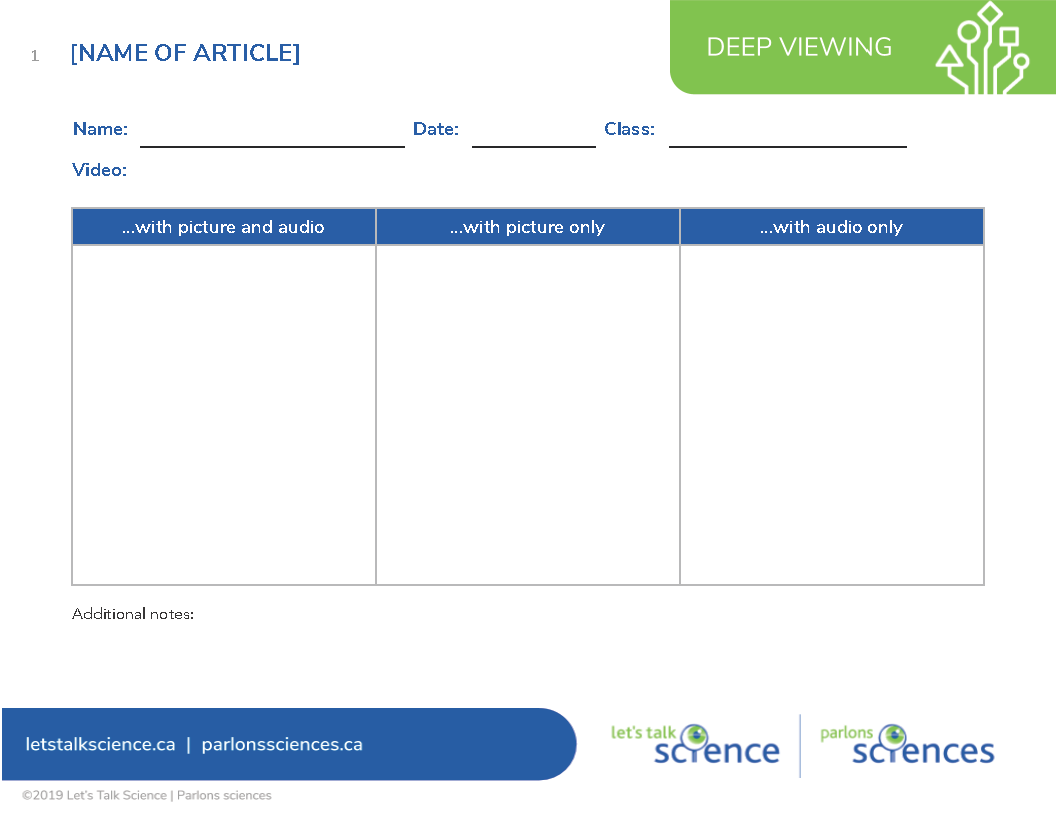Deep Viewing

Students watching and listening to video (FatCamera, iStockphoto)

Students watching and listening to video (FatCamera, iStockphoto)
Format
How does this align with my curriculum?
PE
5
Integrated Curriculum Grade 5: Science (Draft 2023)
IS 1.4: Collaborating with others effectively can help us to share meaningful explorations in impactful ways.
PE
6
Integrated Curriculum Grade 6: Science (Draft 2023)
IS 1.4: Collaborating with others effectively can help us to share meaningful explorations in impactful ways.
PE
6
Integrated Curriculum Grade 6: Science (Draft 2023)
IS 1.4: Effectively communicate the results of their inquiry.
This strategy helps students to gather and summarize information from a video.
Why use it?
- To make video viewing more interactive than passive
- To help students focus their viewing of videos
- To help students summarizing information presented through videos
- To support students who are visual as well as auditory learners
Tips for success
- This strategy works well with videos that are very fast paced and dense with information.
- Choose a video or a piece of a video that is not too long in length. If the video is long, then the video should be chunked to help students summarize the information.
How do I use it?
- Provide each student with a Deep Viewing reproducible for the video. This can be made from the Deep Viewing Template (see image at right).

- Students summarize the information presented in the video by writing in the first column “...with picture and sound” while they watch the video.
- Replay the video with only the picture.
- Students summarize further information which they gather while viewing the video without sound and add it to the second column “...with picture only.”
- Replay the video with only the audio.
- Students summarize further information which they gather while viewing the video without visuals and will add it to the third column “...with audio only.”
- After the video has been viewed in all three methods, the students:
- read their notes to one another in pairs or small groups
- make additions or revisions to their notes
- write the pooled information on chart paper
- report to the whole class
Variations
- If the video has many visuals, such as labelled diagrams, start with viewing the picture only.
- If the video has very descriptive audio, then start with the audio only.
- Not all three viewing methods need to be shown; however, picture and audio together should always be shown as one.
Extensions
- As a more enriching strategy, students are instructed to not only record what they see but also engage with it by:
- asking questions
- noting unique or difficult vocabulary
- stating feelings
- making connections
- challenging or objecting to what they hear
- creating a visual response
Using this Strategy
Deep Viewing Reproducible Template [Google doc] [.pdf]
- The Deepest Hole in the World, and What We've Learned From It: Deep Viewing Reproducible [Google Doc] [PDF]
Create Your Own
Deep Viewing Reproducible Template [Google doc] [.pdf]
Ready to Use
- The Deepest Hole in the World, and What We've Learned From It: Deep Viewing Reproducible [Google Doc] [PDF]
References
Cambridge University Press blog (2015, October 22). 5 ways to use video in the classroom.
Denning, David. (n.d.). Video in theory and practice: Issues for classroom use and teacher video evaluation. InNATURE Productions.